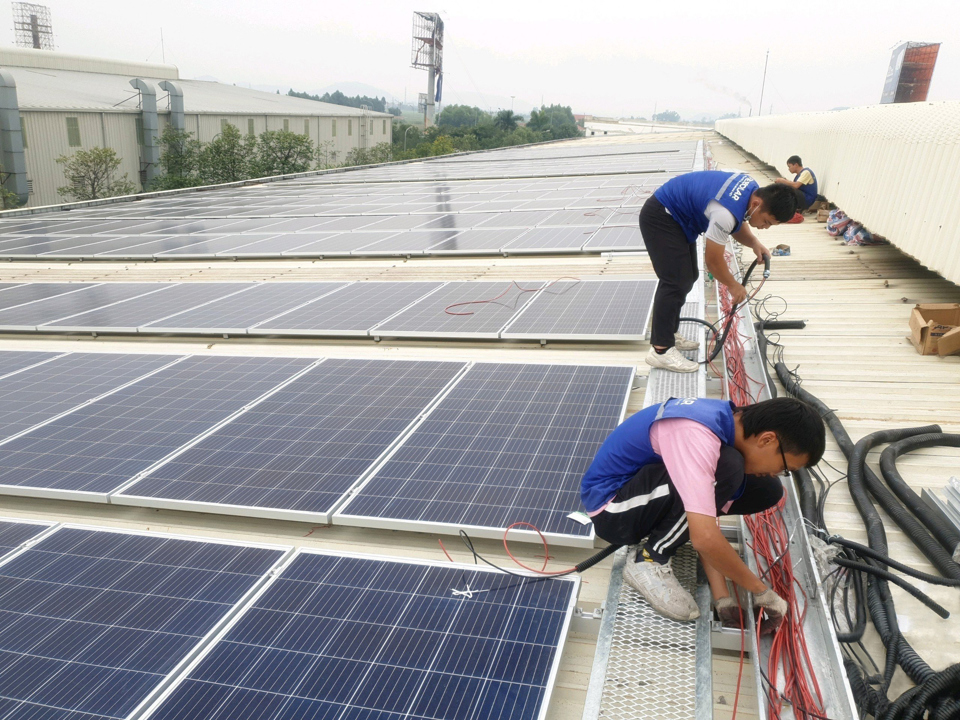
The Ministry of Industry and Trade proposes temporarily applying a purchase price of VND671 (US$0.026) per kWh for excess self-generated rooftop solar power fed into the grid.
| Installing roof-top solar power. Photo: Hoang Anh/The Hanoi Times |
Earlier, to encourage the development of clean energy, Deputy Prime Minister Tran Hong Ha instructed the Ministry of Industry and Trade to pilot a program allowing excess self-generated rooftop solar power to be sold to the national grid, with a cap of 10% of total capacity. The ministry has also been asked to set a purchase price for the excess electricity from self-generated rooftop solar systems.
In a report dated July 11, the Ministry of Industry and Trade presented several pricing options. The first option sets the purchase price based on the average annual avoidable cost tariff schedule issued by the Ministry. The avoidable cost rate is the cost of producing 1 kWh, adjusted for time of use and regional and seasonal variations. It applies to small renewable energy plants, such as small hydropower plants, without specific tariffs.
The second alternative is to base the price on the System Marginal Price (SMP) for each hour (excluding capacity market prices - CAN) minus the distribution cost per kWh. This price reflects the cost of the last generating unit or plant dispatched to the system.
However, the ministry concluded that there is no suitable method for setting a price for surplus electricity, making it difficult to justify the use of either of the proposed options.
Therefore, the authorities propose a temporary purchase price of VND600-700 per kWh for excess power fed into the grid, or VND671 per kWh (based on the average avoidable cost tariff schedule for 2023). This rate is 58-63% lower than the current purchase prices for transitional renewable energy projects, ranging from VND1,587 to 1,816 ($0.062-0.071) per kWh.
The Ministry of Industry and Trade suggests this price could be adjusted annually to align with the development of the electricity system. This approach is simple, easy to implement, and cost-effective for EVN.
Regarding the pilot project to purchase up to 10% of the total capacity of surplus power, the Ministry noted that this would incur high costs since consumers would need to install devices to limit export and subsequently deter investment.
Thus, the ministry proposes purchasing no more than 10% of the total excess electricity fed into the grid. This aims to encourage investment, simplify implementation, save investment costs, and avoid negative outcomes and waste of social resources.
Vietnam has around 103,000 rooftop solar projects with a total installed capacity of over 9,500 MW.
According to the National Power Development Plan VIII (PDP8), the capacity of this source is expected to increase by 2,600 MW or cover 50% of office buildings and households by 2030.
Previously, during the drafting stage, the ministry had stated that it was not keen on buying excess self-generated rooftop solar power due to its instability and dependence on weather conditions. The ministry had proposed to purchase excess production at a price of zero dong. However, feedback from experts suggested allowing consumers to sell excess power to the grid, with regulatory limits on the surplus to prevent policy abuse, particularly in industrial zones and clusters.






- Vietnam’s hi-tech firms urged to master semiconductors, AI technologies
- Vietnam to develop small-size nuclear power plant
- Vietnam's institutional reforms critical to achieving 2025 growth targets
- Prime Minister reaffirms reaffirms commitment to enhancing investment climate
- PM visits domestic firms joining high-speed rail project
- Vietnam e-commerce sales to hit $15.4 billion in 2025

